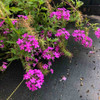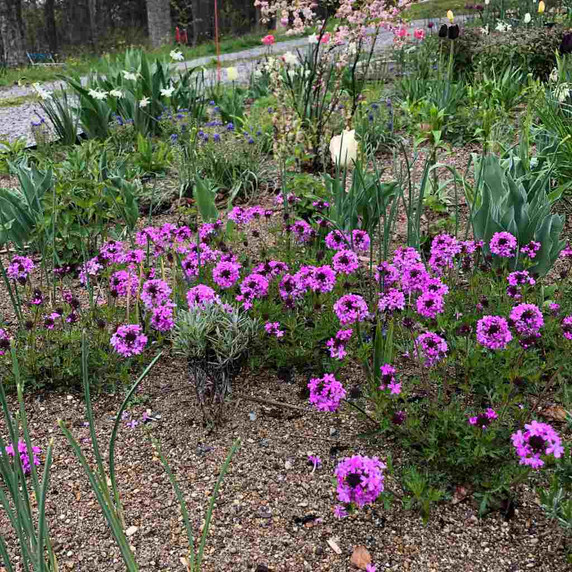
Verbena canadensis ' Anna's Pink' (Glandularia canadensis) - ROSE VERVEIN 'ANNA'S PINK' (zone 5 hardy)
Ground covering perennial, with long flowering season, drought, heat and humidity tolerant, zone 5 hardiness - North Indiana genotype.
Bright rosy-pink flowers and flower clusters with very dark heads.
We were searching for hardy genotype of this native beauty for over 2 years, but seeds are often not available, plants neither, but then this gem crossed our paths. Thanks to John Chapin (Tree Frog Gardens/Chapin Landscaping, Danville, IN) we got 5 plants originated from now non-existing north Indiana nursery! All the plants are clonal - vegetatively propagated - that originate from one plant that John Chapin bought years ago. Because there are more forms coming to the market, John Chapin decided to name this form 'Anna's Pink' after his daughter (and grandmother Anna), who immigrated to USA from Poland. We proudly continue in introducing this great plant to wider market.
Natural area of this very showy wildflower is wide, reaching from deep south to north, also from central USA to the east coast - that's why the hardiness differs so much and plants from southern areas act like true annuals, while the "northerners" are perennials. See the USDA distribution map.
The most common and readily available on the market, is Verbena canadansis 'Homestead Purple' - which is dark purple flowering vervain, but it was discovered in Georgia (Allan Armitage, Michael Dirr) and is lot more tender, and is usually grown as annual. Our plant are verified hardy in zone 5.
1' tall x 2' wide, slowly creeping wide, clusters of fresh rose pink flowers continuously from May till fall freeze, but with more sporadic flowering during hot summer.
Full sun, virtually any soil, that is not wet or waterlogged - average soils, heavier, but drier soils, drier clay, rocky, sandy, gritty soils with average moisture to dry. Prefers some drainage (soil amended with some sand or fine gravel, but can handle clay, if it is dry clay).
Hardy in zones 5-9.
It is not pollinator magnet, but occasionally attracts some pollinators - hummingbird moth and potentially some native bees.
Excellent for the front of a sunny borders with average to dry soil.
Looks very well with yellow flowers (Coreopsis, Rudbeckia hirta, Rudbeckia missouriensis, new shorter cultivars of Rudbeckia), but other perennial comapions can be Agastache, Asclepias (A. tuberosa, verticilata), Gaura, Nepeta, shorter Liatris, Lavandula, Penstemon, and others, or grasses like Eragrostis, Muhlebergia, Koleria cristata,Sporobolus and Schizachyrium scoparium.
Pot size : square 3.5" x 4" deep perennial pot
Picture copyright : US Perennials

Verbena canadensis ' Anna's Pink' (Glandularia canadensis) - ROSE VERVEIN 'ANNA'S PINK' (zone 5 hardy)
Ground covering perennial, with long flowering season, drought, heat and humidity tolerant, zone 5 hardiness - North Indiana genotype.
Bright rosy-pink flowers and flower clusters with very dark heads.
We were searching for hardy genotype of this native beauty for over 2 years, but seeds are often not available, plants neither, but then this gem crossed our paths. Thanks to John Chapin (Tree Frog Gardens/Chapin Landscaping, Danville, IN) we got 5 plants originated from now non-existing north Indiana nursery! All the plants are clonal - vegetatively propagated - that originate from one plant that John Chapin bought years ago. Because there are more forms coming to the market, John Chapin decided to name this form 'Anna's Pink' after his daughter (and grandmother Anna), who immigrated to USA from Poland. We proudly continue in introducing this great plant to wider market.
Natural area of this very showy wildflower is wide, reaching from deep south to north, also from central USA to the east coast - that's why the hardiness differs so much and plants from southern areas act like true annuals, while the "northerners" are perennials. See the USDA distribution map.
The most common and readily available on the market, is Verbena canadansis 'Homestead Purple' - which is dark purple flowering vervain, but it was discovered in Georgia (Allan Armitage, Michael Dirr) and is lot more tender, and is usually grown as annual. Our plant are verified hardy in zone 5.
1' tall x 2' wide, slowly creeping wide, clusters of fresh rose pink flowers continuously from May till fall freeze, but with more sporadic flowering during hot summer.
Full sun, virtually any soil, that is not wet or waterlogged - average soils, heavier, but drier soils, drier clay, rocky, sandy, gritty soils with average moisture to dry. Prefers some drainage (soil amended with some sand or fine gravel, but can handle clay, if it is dry clay).
Hardy in zones 5-9.
It is not pollinator magnet, but occasionally attracts some pollinators - hummingbird moth and potentially some native bees.
Excellent for the front of a sunny borders with average to dry soil.
Looks very well with yellow flowers (Coreopsis, Rudbeckia hirta, Rudbeckia missouriensis, new shorter cultivars of Rudbeckia), but other perennial comapions can be Agastache, Asclepias (A. tuberosa, verticilata), Gaura, Nepeta, shorter Liatris, Lavandula, Penstemon, and others, or grasses like Eragrostis, Muhlebergia, Koleria cristata,Sporobolus and Schizachyrium scoparium.
Pot size : square 3.5" x 4" deep perennial pot
Picture copyright : US Perennials
Customer Reviews
-
Verbena Anna's Pink
I purchased one of these early in the Fall, and then decided to get one more in late Fall. Love the story behind this plant, and can't wait to see it in bloom next year.












